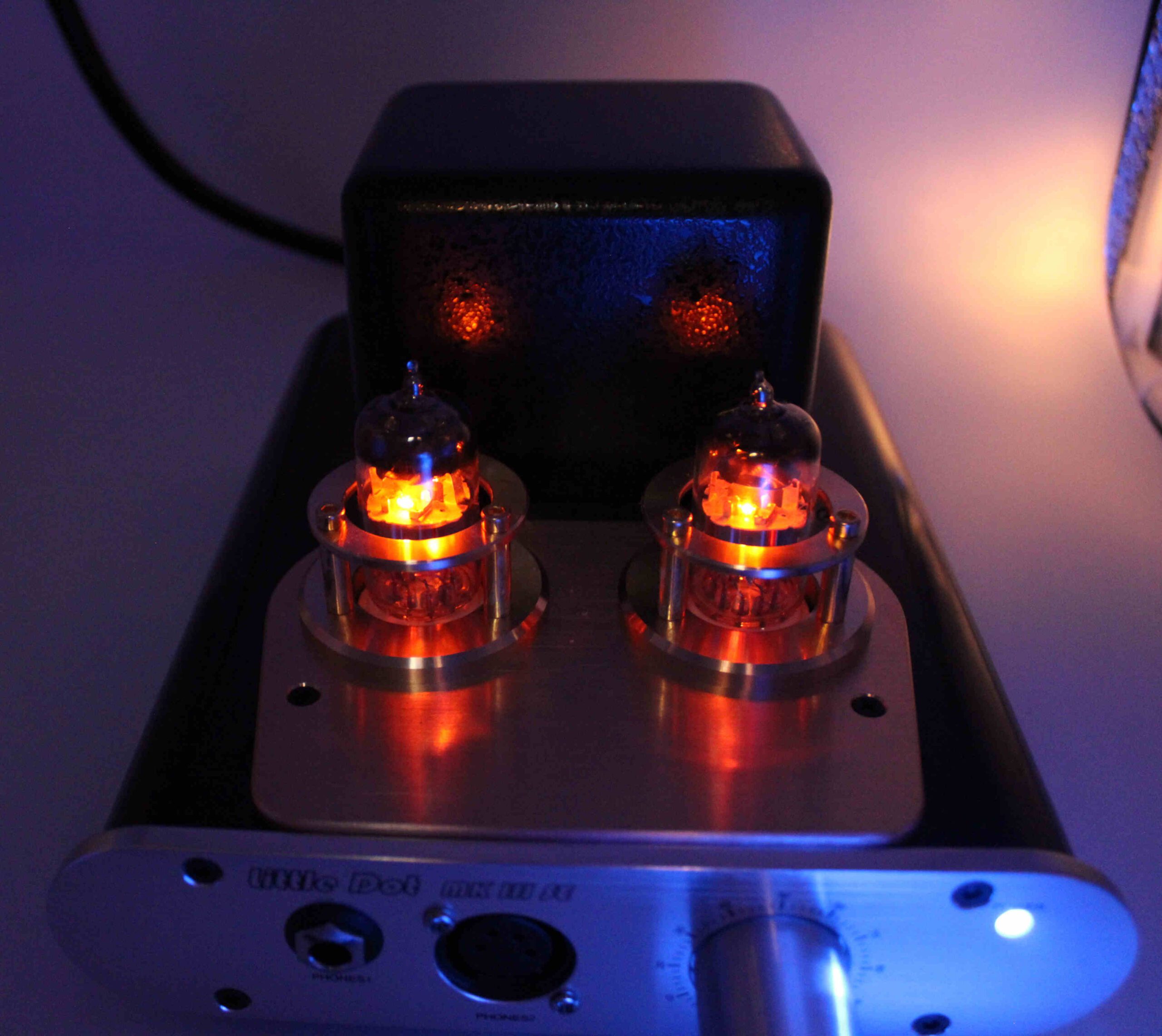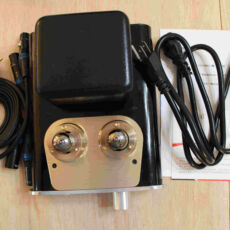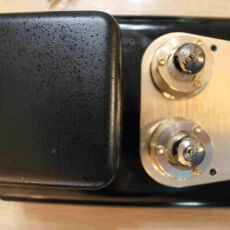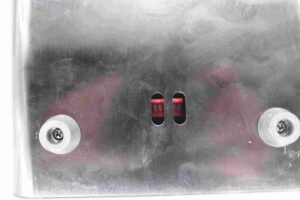LittleDot MK III SE
LittleDot MK III SE is a fully balanced hybrid headphone amplifier by this legendary Chinese manufacturer. It pushes up to 2.5W per channel and it's priced at $499.
| Price | Type | Balanced | Power |
|---|
| $494,99 | Hybrid | Yes | 2,5W |
| | | |
Introduction
Years go by, more and more manufacturers come to the market, giving us the most exciting time for being an audio enthusiast…well, ever. Some of them have been here for a long time though, and LittleDot is definitely one of them. I personally remember using their MK III and MK VI+, especially the latter, which had its own place on my desk for about 2 years back in a day.
It wasn’t perfect – the idea of having a tube amp with active cooling in form of two fans on the bottom is…you know, ridiculous. And if you haven’t changed those for some high-end Noctua fans, then you’d end up with a constant noise coming out of your amp. That’s not all, it was a balanced amplifier, but it had a 6.3mm output, right? Yea, it had….on the back panel, which (till this day) is probably the most absurd build feature I’ve ever seen in this hobby.
It all didn’t bother me that much though, as after the second of listening to this marvelous amplifier I knew, that I’m using something of really high quality.
Ultimately, I’ve sold the VI+ and kinda missed it ever since, but it wasn’t perfect, so it helped a bit to get used to not having this beast. Many years have passed, I changed almost everything in my life, and once again I’ve got a LittleDot amplifier on my desk, and guess what…I’m loving it.

Packaging
Let’s start with the least exciting stuff – the packaging.
What can I tell you, the MK IIISE comes in a box…and that’s about it if you ask me. It’s a plain cardboard box with nothing worth mentioning. It’s secure, protective, and gets its only job done – protecting the amplifier on its way to your house. As the IIISE came completely untouched to my doorstep, I must say that it did its job just right.
Next up, the included accessories. You’re getting two pairs of interconnect cables – one RCA, and one XLR. They are respectively 1m and 0,5m in length, and honestly, these are really generic Chinese cables. It’s a really good thing that you’re getting them for free with your purchase, as you won’t be chasing to the nearest electronic shop for the cables if you ain’t got them at this point. Still, if you’ll get serious about all of this, I’d highly recommend getting some nicer cables, as the ones included in the box are really nothing special. They’d get you running, but that’s about it. Still, a very good thing is that they’ve included them.
Build Quality

The LittleDot MK III SE is not too big, but it’s quite heavy. I’d say it’s a perfect size for any desk scenario, including an office or a bedside table, as you really don’t want to use a huge, monstrosity of an amp in those two places.
Back to the amp though, it looks really good but definitely won’t suit everyone’s taste. I really like the gold element which also protects the tubes, but it has the “vibe”…well, you know what I’m talking about. Still, it’s cool looking for me, as it’s looking like a Soviet Union/Future collaboration. I definitely cannot say anything bad about the build and finish, as it’s really, really solid. Everything feels secure, well-made, and built to last. I also like the black paint with that “dotted” effect on the transformator, which adds a little bit of depth to the design.
Another important thing about an amplifier is the volume knob, and the one installed on the III SE is actually great to use. It’s not the smoothest and most pleasant, but it feels extremely secure and solid, as it was built to last literally forever. And you know that volume knobs happen to fail sometimes…I doubt that’ll ever happen to you while using this amplifier.
After a while of using it, the amplifier will get warm. After a couple of hours, it’s going to be hot. You’ve got both tubes and Class A, which are known to generate a lot of heat. The golden element that protects the tubes gets unbearably hot after a couple of hours for me, but remember that my hands are very delicate for that kind of stuff. Nonetheless, there’s absolutely nothing to worry about, the amplifier was designed to run hot. Actually, there are people in this hobby that believe, that if it’s not getting hot while using it, it can’t be good. Well, I wouldn’t go as far, but for such an amplifier to generate a large amount of head, is totally normal. Don’t worry.
The con I have to point out though is the blue led light on the front panel. It’s ridiculously bright, I’m actually thinking about opening the amplifier up and unplugging it. They could have gone for a delicate orange led instead, because this blue one illuminates a large portion of my desk at night. Nitpicking, I know, but it really bothers me.

Tech

When it comes to what’s inside the III SE, it all impresses. It’s not a tube amplifier actually, but a hybrid one. It means that the tubes are responsible for the preamplifier stage, adding that legendary warmth and lushness to the sound. When it comes to the driving abilities though, it uses a fully discrete and pure class A circuit design. That’ll basically give you the best of both worlds – the timbre and richness of a tube amplifier, and powerful, raw power thanks to the transistor circuit.
As for the tubes, it uses two 6N11 double triodes, which are interchangeable with ECC88 and 6922, so you’ve got plenty of choices when it comes to tube rolling. I haven’t tried it, as I shouldn’t really change anything as a reviewer, to not make any wrong impressions. Keep in mind though that you totally can try some different, better tubes to make the amplifier sound much, much better. There’s so much potential in this, that it’s basically a feature that you can’t underestimate.
Apart from that, the amplifier is fully balanced, which means that it definitely sounds the best with a balanced source connected via XLR interconnects, and you really want to use the XLR headphones output on the front, instead of the 6.3mm jack. It simply delivers a much better sound quality doing that, and that’s the most important thing about it, right?
You can also choose between two gain settings – LOW, which has 4.5 magnification, and HIGH, which has 9. I basically tend to leave it on HIGH setting all the time, since I’m using Over-Ear headphones only while around my desk.
Sound

Pure class A circuit design, fully balanced, fully discrete, tubes on the preamplifier stage…it really has to sound really nice, doesn’t it? Well, that’s exactly the case here with the LD MK III SE, and it packs the best aspects of both tubes and SS amplifiers. But let’s start from the beginning.
The
bass is what you would expect from a class A, powerful amplifier – it’s big, bold, and extremely saturated. No matter which headphones from my current collection I plugged into it, I didn’t hear a hint of trouble with any of them. This is an extended, rich, and well-controlled bass response delivery, and that’s probably the biggest difference between a hybrid design and a full tube amplifier. Thanks to a lot of power that this amplifier outputs, as well as it being clean and uncompressed, you can be sure that you’ll get the bass you were meant to when you were buying your headphones. Fair, it won’t drive the Susvara, 1266 or HE-6, but that’s about it, and this little guy is $499.
Don’t make the raw power fool you though, as it’s clearly not everything. The bass represents everything good about class A amplification, providing you with a thicker, meatier, and more powerful note delivery. Say goodbye to thin and light-sounding low frequencies, unless you have really bass-light headphones.
The
midrange is rather surprising. Looking at the tubes and class A circuit, you could have thought that this little guy will sound really thick, lush, and warm, and you would have been really wrong. It is actually quite close in timbre to my SMSL SH-9, just a little bit warmer and more delicate, but it’s a slight difference.
Having that in mind, you’re getting a very clean, forward sounding and resolution packed midrange that’s pretty easy to love. Every single instrument and vocal sound natural, rich and engaging, but it’s not a “tube sound” vibe, definitely. I’d say that the midrange is more reminiscent of a Class A amp, rather than tubes. You don’t hear that harmonics and distortion that the tubes implement. Instead, you’re getting a fully saturated, heavy, and big sound that sounds very crisp and clean. It is quite comparable to my SH-9, and that is one of the best measuring amplifiers in the market, regardless of the price – that’s very impressive for the III SE.
As stated before, vocals do sound very natural and lifelike, and I can’t even name you a single pairing or song where the vocal presentation would have sounded off to me. This is a very musical and real-sounding amplifier, that’s not trying too hard to be sounding “specific”. It’s a classic class A approach that would always work, as it just sounds really pleasant and correct.

The
treble is impressive, packed with details, and engaging, but you’d want to audition the III SE first if you’re sensitive to any brightness in the high frequencies. It does sound slightly sharp sometimes, it’s prominent with both Hifiman HE1000se and Final D8000 Pro, which are known for their superbly detailed and accurate treble response. I had no problems whatsoever with my Audeze LCD X (2021) or the HEDDphone, so if you’re having one or both of these, you can stop worrying right now, as you won’t be having any problems.
Nonetheless, back to the treble. The amount of details is very good, especially for a “tube” amplifier, but it does retrieve them in a rather natural fashion. It doesn’t sound like a sound microscope, which throws every single detail right in your face. They do appear, but as a part of the whole sound, resulting in both pleasant and technically strong sound signature. Don’t get the III SE if you’re looking for a laid-back treble experience though, as it is very far from the truth in this regard. This is a true Solid State type of experience when it comes to the treble – energetic, clean, shimmering, and forward sounding. It really helps string instruments and female vocals sound impressively open, razor-sharp, and clean.
When it comes to
soundstage and imaging, the III SE is a chameleon. It’s definitely not an amp that’ll make the stage bigger. It’ll completely depend on your choice of headphones that you’ll use, and the III SE definitely won’t get in the way. It allows some soundstage masters to shine really bright, as for example my Hifiman HE1000se. It’s wide, deep and the imaging is marvelous. At the same time, it’s not making the soundstage of my Audeze LCD X (2021) any bigger than it really is. Even though the imaging in spot-on, its staging is rather intimate and close to your head, and the III SE gave me just that, without changing anything.
Pairing
Hifiman HE1000se

HE1000se is not a power-hungry pair of headphones, so you don’t really need a powerful amplifier to make them sing. Still, because of their ridiculous detail retrieval and speed, you really want to give them high-quality source components, and the III SE is a brilliant choice in the $500 market. While its Class A timbre will make the 1000se thicker and more colorful sounding, it’s not compromising any of their technical capabilities. Razor-sharp imaging, brilliant resolution, and details for life, while having that big and heavy note delivery proves to be a great setup. The III SE is always fun to listen to, and it’s definitely the case in this pairing.
Final Audio D8000 PRO

D8000 Pro definitely needs more juice than the 1000se, hence the output power of the III SE comes handy in this scenario. I don’t hear any problems with driving the headphones, but have in mind that I’d strongly recommend tube rolling for this combo. The stock III SE happens to be bright and a bit sharp in the treble region, and the D8000 Pro is definitely not a laid-back sounding headphone. Because of that, its upper frequencies can get a bit too much for some.
It is the only con though, as the rest of the spectrum happens to be fantastic. This combo sounds very natural, especially the vocals. Once again the III SE proves to have a brilliant detail retrieval and paired with the superbly-detailed D8000 Pro gives us a highly resolving and highly technical sound performance.
While there may be better companions for the Finals flagship, the III SE is a great choice in its price, giving us a universal and natural tuning and great technicalities.
HEDD Audio HEDDphone

And now into the best pairing – the HEDDphone. They do require a fair amount of power to sound the best, and the III SE has plenty. No problem with driving them to their full potential whatsoever. When it comes to the tonality, it’s absolutely brilliant with thick notes, hyper-natural vocal presentation, and airy, extended treble. The HEDDphone itself isn’t really prominent in the lower-treble area, and this amplifier boosts this frequency a bit, which results in a crispy and forward delivery without a hint of sharpness. The HEDD has this unique timbre and staging capabilities, and they do sound amazing with the III SE.
This headphones + amplifier combo is under $2500, and I honestly can’t think of a better buy at this price, if you’d be looking for a superbly resolving, musical, and fun sound performance. Really pleasant to listen to, while keeping it on a high-end level when it comes to technical capabilities. Brilliant.
Comparison
VS SMSL SH-9

This comparison is really interesting because the SH-9 is one of those crazy clean, marvelously measuring amplifiers with lots of power. Thanks to that, its sound is so clean, detailed, and packed with resolution that it’d cost you a couple of thousands a few years back to get this kind of performance.
What’s surprising is that the LittleDot MK III SE performs quite familiar, also providing that speed and texture with high power output.
There are differences though – the SMSL is a bit colder, less colored and its note delivery is thinner. While it doesn’t sound as natural and fun to listen to, it’s worth noting that it’s also almost two times more affordable than LittleDot.
So, why would you get the latter? It’s simple – if you want that thicker, more powerful Class A sound performance, and you’d like to have fun with different tubes to change the sound, the III SE is simply a better amplifier, and definitely more prone to upgrades. The SH-9 is a done project, you can’t simply open it up and modify it to your liking, which you can easily do with the III SE.
Also, the timbre is more natural and lifelike when listening to the III SE, but keep in mind that it’s not a night and day difference. Having in mind the topology though, I’m very impressed that it performs on the same level as the SH-9 when it comes to technical performance though. Trust me, it’s not easy to reach that kind of quality with tubes and Class A.
Long story short – get the SH-9 if you want the best possible quality on a budget, and get the MK III SE if you want a more natural sound that you can tweak to your liking with different tubes.
Summary
 Little Dot MK III SE is a fantastic hybrid headphone amplifier for the money. The build quality is really good, it’ll drive a majority of headphones on the market, and its Class A, hybrid timbre is just a treat to listen to. Have some fun with the tubes and you might end up with an amplifier for many years.
Little Dot MK III SE is a fantastic hybrid headphone amplifier for the money. The build quality is really good, it’ll drive a majority of headphones on the market, and its Class A, hybrid timbre is just a treat to listen to. Have some fun with the tubes and you might end up with an amplifier for many years.
Highly recommended.
Gear used during this review for the sake of comparison and as an accompanying equipment:
- Headphones – Fir Audio M5 Custom, Final A8000, Campfire Audio Solaris 2020, Hifiman HE1000se, Final D8000 Pro, Audeze LCD X 2021, HEDDphone
- Sources– Cayin N3 Pro, iBasso DX220, SMSL SU-9, JDSLabs Atom DAC+, Accuphase DP-570

























 )
)







